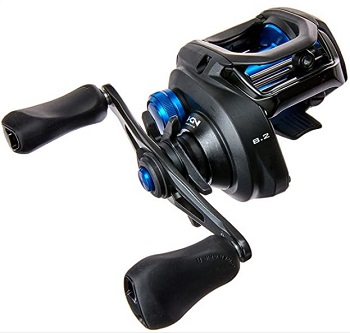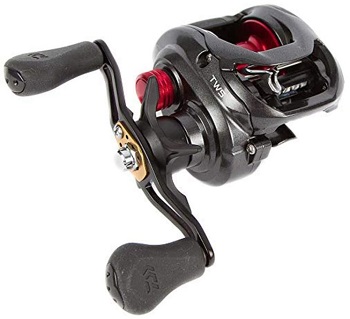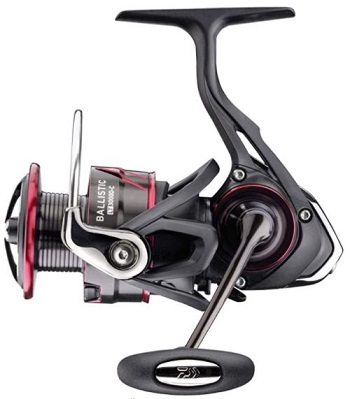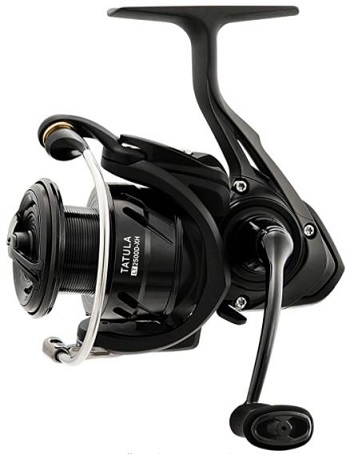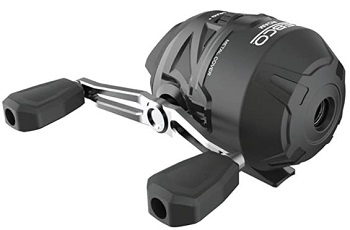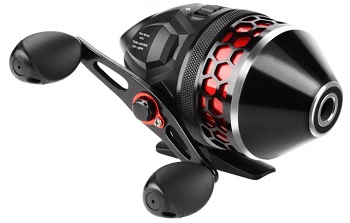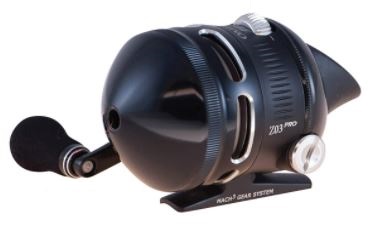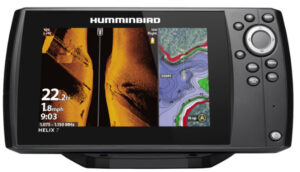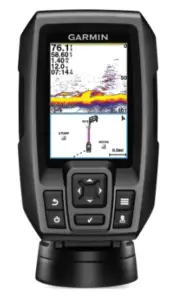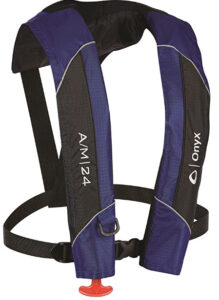What are the best bass fishing reels? | What reels to use for bass fishing?
The best type of bass fishing reels are based on a variety of factors such as technique, experience, and personal preference. There are many kinds of fishing reels that are used in many different ways and each type of reel has its pros and cons. If you are fishing a crankbait, or jig fishing you want to use a stout heavy-duty baitcasting rod. However, if you are fishing a drop shot rig, or weightless Senko you’ll want to use a spinning reel. Again, it really depends on the application.
To make it easy on you we’re giving you the complete breakdown of what reels to use for bass fishing. We’re also giving you the Ultimate Bass Fishing Reel Reference guide for you to utilize for a quick reference.
We’ve Been In Your Shoes… We’re Anglers Too!
We used and abused hundreds of different reels.
We read through hundreds of customer reviews, watched tons of video reviews, and listened to what the professionals and experts had to say from popular sources like BassMaster Magazine, FLW and other industry leaders.
We scrutinized the data from the product catalog pages of nearly a dozen manufacturers, and we even tried to interview some of the company representatives to talk shop and get their take.
We even collected indisputable data, collected real-world examples to be able to give you the most complete unbiased product review we could create
Together we’re giving you the edge by teaching you how to choose the best bass fishing reel for your specific situation. We tried to cover as many situations as we can, but if we left any out feel free to comment below and we will add it if we can.
WARNING: There’s a lot of information about this subject you’ll probably want to come back to. No one expects you to remember all these tips. We know your time is precious, so we really tried to over-deliver in value for you. Additionally, we frequently update reports like this, so you’ll want to stay up to date with any changes or additional tips we include for you.
We found that the easiest way to save and bookmark this report so you can come back to it later is to share it on your favorite social media platform, especially if you use your phone to get important tips like the ones in this report here…
Click on your favorite social media buttons to remember this page now!
In A Hurry?
If you don’t have much time to read the detailed reviews, simply use the links below to quickly find the best finesse rod for the money on Amazon. You can be assured we only choose the best products…
- Best baitcasting reel for the money: Shimano Chronarch MGL Baitcasting Reel
- Best spinning reel for the money: Daiwa Tatula LT Spinning Reel (TALT25000D-XH)
- Best spincast reel for the money: KastKing Brutus
What Type of Reels are Used for Bass Fishing?
If you’re like me, you want to know WHY a specific type of reel is best for that application. Well, in the following sections, we’re giving you all the secrets the industry does not want you to know about.
You may already know, there are two main types of reels used by most bass anglers; baitcaster reels and spinning reels.
There are spincasting reels, however, most angles may start with these but will graduate to either the baitcaster or spinning reel for the sake of quality and dependability.
Each style of reel has qualities that make them better than the others depending on the technique you are fishing with, so it really depends on what application you’re going to use it for.
Bass fishing is a very situational specific sport.
Anatomy of a Fishing Reel
As you can guess the anatomy of any specific reel will vary from style to style. However, most will have some of the same basic parts:
Line Pickup – This either winds/wraps the line over the spool.
Spool – A sprocket-like structure on which the line is wrapped around.
Engager/Disengager – This is a mechanism that allows the line to come off the spool or locks it the line in place.
Drag Component – This slows the line coming off the reel.
Handle – This helps turn the internal gears to retrieve the line back onto the spool.
Reel Seat – The section there the reel rests on the fishing rod.
Break System – Advanced system on baitcasting rods to help slow the spin of the spool after your lure hits the water.
What is a Baitcaster Reel?
How To Cast A Baitcaster | How To Adjust A Baitcasting Reel | Fishing Reel
Baitcasting reels are a staple in any pro bass angler’s arsenal and we will definitely delve deep into them later on in this article.
These type of reels are used for a variety of reasons, everything from fast moving crankbaits to slow crawl jig fishing.
Read more: What is Jig Fishing For Bass?
Bait casting reels or casting reels look and work a little different from spinning reels; they also take a little more effort to use.
The mounted reel is on top of the rod and have a spool that is perpendicular to the rod.
If you remember, the spinning reel spool is stationary, but in a baitcasting reel, the spool actually spins to allow line on or off.
It takes some time working with these to avoid the oft happened “bird’s nest” or tangle of line.
Baitcasting reels do allow for better control and comfort when fishing.
Bass fishing requires you to be versatile and you must have the ability to change baits at a moment’s notice. Baitcasting reels are great because the can be used for many different applications and have special designs for just that case.
A few things, size and gear ratio can break them down.
Size
While most bass fishing setups come with a “100”, size or “150” size reel, which is expected, for throwing baits less than 2 ounces, there are a few other options.
Since the fishing line does not require it to be “twisted on” a spool that is fixed, it’s wound on much like you would see on a winch on a jeep.
The end result is that you can use a stronger/heavier line and cast out must farther distances.
If you are one of the anglers who enjoy throwing large swimbaits or glide baits (3-5 ounces), you must make sure you are using a baitcasting reel that has a 300 or 400 spool. They are a little bigger to hold the thicker or stronger line and more of it, and for using larger, heavier baits.
Less Line Twist
One of my biggest pet peeves with spinning reels is the line twist! Line twists can ruin what would be an otherwise perfect cast.
Since baitcasting reels wind the line perpendicular on the spool, there is will be a very low chance of any line twist.
It’s important to note that using different fishing lines will twist less often. So it’s vital that you familiarize yourself with the different fishing lines to make you more successful.
Read more: 21 Tips To Choose The Best Bass Fishing Line
Speed or Gear Ratio
Like discussed earlier the gear ratio is the amount of times the line goes around the spool per handle revolution. The difference with baitcasting reels is the spool actually makes a revolution to put the line on it.
This is crucial for a baitcasting reel, it helps dictate the reel you will use more often than not.
The different speeds will help dictate the baits thrown with each reel, for instance, a speed or ratio of 5.4:1 would be a great reel for deep crankbaits.
We can break gear ratios down into three main categories; slow (5.9:1 or lower), moderate (6:1 thru 7.2:1), and fast (7.3:1+).
Most circumstances, “slow” baitcasting reels (5.9:1 or lower) are for used wakebaits and crankbaits as it gives the bait its necessary action and allows the bait to remain in the strike zone longer or allow the bait to dive and not hurry back to the boat.
Moderate speed baitcasting reels (6:1 thru 7.2:1) are suited for many other applications, such as jerk baits, spinner blades, swim jigs and other moving baits.
Lastly, fast gear ratio (7.3:1+) baitcasting reels are best suited for jigs, flipping, worming, and punching in order to get the slack reeled in and move those fish out of the cover in hurry.
Since the spools move on casting reels, they have a braking system to stop them and avoid backlashes or “bird nesting”.
Braking System
The braking system applies tension to the spool to slow it down and stop it after the lure has hit the water and stopped taking line out. This is very important if you’re flipping or pitching lures into grass or tight spots.
This prevents the line from coming off the spool inside the reel and making a tangled mess. There is a spool tension knob found on the reel handle side, this is your beginning defense to prevent a tangled mess.
You can add tension to the spool by tightening this knob, but be careful, too tight and it will not cast far at all.
There are two main types of brake systems, centrifugal brakes, and magnetic brakes. Centrifugal brakes utilize friction to slow down the spool. There are some pins that you can engage or disengage. They are located inside the reel on the opposite side of the handle (read your instruction manual for more details). Magnetic brakes use magnets to slow down the spool and can be adjusted.
Some reels try to simplify this by putting a small numbered dial on the outside of the reel that the angler can adjust.
Maybe now you can see why most beginners just choose the spinning reels.
Accuracy
Using a baitcasting reel gives most bass angler’s an incredible amount of confidence. When compared to a spinning reel, the angler can slow down the bait by applying pressure to the spinning spool with his/her thumb.
This provides an insane amount of accuracy to put your lure on “the spot-on-the-spot”!
What is the best baitcasting reel for bass fishing?
– Best Budget –
Shimano SLX Baitcasting Reels
This reel is incredably smooth with a fast retrieve. The rubberized handles which feel have a higher quality feel. Low profile reduces wrist fatigue. This reels easlily competes with reels in the $130 ranges. Great entry reel for the price.
- Silky smooth casting, even with lightweight lures
- Ergonomic thumb grips
- 6.9-ounces
- Body flexes
- reports on difficult to adjust the brake system
– Winner! –
Shimano Chronarch MGL Baitcasting Reel
Thousands of anglers agree this reel feels smooth, solid, and reliable. Casting distance improved 15% after re-tooling the Magnumlite spool. The ultra-smooth gearing system allows for consistant smooth drag that’s proven to prevent fish from breaking the line.
- Buttery smooth casting and retrieves
- Improved durability
- Reduced weight
- Seamless drag
- Quick adjustments
- Weighs only 6.5-ounces!
- Pricey
– Runner Up –
Daiwa Tatula CT Baitcast Reel
The Daiwa Tatula CT baitcasting reel delivers incredible casting performance for a wide range of bass fishing applications, all at a great price. The T-Wing System reduces line friction which improves casting distance for even the lightest of lures.
- Easy to cast
- Works well with any type of bait
- Easy set up
- 7.4-ounces
- Thumb button feels cheap
- T-wing makes it hard to cast line-to-leader rigs. The knot will get caught up
How to put line in your baitcasting reel
How To Put Line on a Baitcaster!
How To Cast Baitcasting Reel - The Overhead Cast
I know a lot of anglers who own baitcasting reels but don’t have confidence in them. In this section, you’re going to learn how to cast a baitcasting reel (and how not to get the dreaded backlash).
How To Cast A Baitcaster (How To Not Get A Backlash)
Hold your rod at a 45-deg angle pointing up.
Choose a bait that is ½-ounce or more and tie it on.
Wind in the bait to the tip of the rod.
Practice Using Thumb: Disengage the baitcasting reel and using your thumb to stop the fall of the bait before it hits the ground. Reel it back up and repeat several times until you feel comfortable.
Step 1: Time to cast your lure. Press the disengaging button to unlock the spool and make sure you keep your thumb on the spool so the bait stays close to the rod tip.
Step 2: Bring the tip of the rod up and over your shoulder about 45-degrees and start to cast forward (in the same motion you chop wood) still keeping your thumb on the spool.
Step 3: As you’re casting forward slightly raise your thumb off the spool allowing the momentum to cast your lure forward.
Step 4: Before your lure hits the ground your water, you MUST press back down on the spinning spool with your thumb. This will prevent any backlashes!
Whalla! You’re casting a baitcasting reel now! Congratulations!
Tune Your Baitcasting Reel.
First, adjust the tension knob. The tension knob controls how fast the “rate of fall” your bait will be.
You can adjust the tension knob by first tightening down the knob all the way first. reel the bait up to the tip of the rod. Then disengage the reel. The bait should NOT move from the rod tip.
Then slowly loosen the tension knob. Once the bait falls to the ground you need to keep the tension knob at that setting.
Then you need to adjust the braking system.
Again wind up the lure to the rod tip and disengage the lure. Let it drop the ground and if the braking system is on a small number 1-3 you’ll notice the spool will continue spinning after the lure hits the ground.
Your goal is to adjust the braking system until the spool stops spinning once it hits the ground. This helps prevent the “backlash” or “birds nest” that every bass angler hates.
Backlashes are caused by the spool spinning faster than the amount of line coming off the spool.
Consider wind conditions. Tighten the braking system (higher the number = tighter it is) the stronger the wind you’re casting into.
If the wind is strong, then tighten it all the way down, especially when you have a lightweight lure. You’ll thank me later.
Then tighten the start drag all the way down until snug (but not so tight you can’t loosen the drag) and then loosen about half a turn.
What is a Spinning Reel?
Why You Need a Spinning Rod for Bass Fishing
Most beginner bass anglers should stick to the spinning reel, as they are easier to fish with and less options and specifics to decide on.
Spinning reels are also used in the bass fishing universe, spinning reels are mostly used for the lighter, softer style of finesse fishing. Some anglers will use spinning reels for much more, but overall there design and ease of use are to help get that lightweight lure (for examples a drop shot bait) out to where those giant bass are hiding.
Read more: Top 10 Drop Shot Fishing Baits You Don’t Know About
Spinning reels have a fixed, open-faced spool positioned in line with the rod. The spool is stationary and a rotor/line guide revolves or spins around the fixed spool.
This type of reel is to mount below the rod.
You can find these reels at any store that sells fishing equipment, and believe me when I say an overwhelming amount will be an understatement.
There are many different species of fish from bluegills all the way to giant tarpon in South Florida that anglers target with spinning reels.
What really separates all the spinning reels from each other?
The first thing to consider before purchasing the reel is the size of reel you will like and need for the type of fishing you are doing.
What is the best spinning reel for bass fishing?
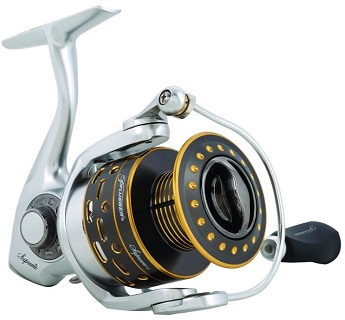
– Best Budget –
Pflueger Supreme Spinning Reel
Excelent entry reel. Not too big not too small. This smooth casting reel features good line management and has nice drag. This reel one of the best values a weekend angler can get.
- Spool designed to accept different types of line
- Durable Magnesium body
- 7.5-ounces
- Bail feels clunky
- Heaviest of these reels
- Reports of the coating on the rubber reel handle peeling off
– Winner! –
Daiwa Ballistic LT Spinning Reel
This lightweight and quiet spinning reel will cast your lure a country mile. The Zaion housing increases strength and decreases weight. It’s one of the smoothest spinning reels ever tested. Very smooth and strong drag. The hand feel is exceptional and feels very comfortable for all day use.
- Comfortable hand feel
- Balanced for all day use
- Strong and smooth drag
- Lightweight bail
- Increased corrosion protection and water resistance
- 6.5-ounces
- Bail can be hard to flip for some
– Runner Up –
Daiwa Tatula LT Spinning Reel
Daiwa have built an incredibly lightweight and reliable spinning reel. The spool is specifically designed to cast any type of line with minimal concern about line twist. Smaller and more compact than it’s competitors.
- Casts like a dream
- Ergonomic design
- Dependable drag
- Only 6.2-ounces!
- Some say it feels "forward heavy"
How to Cast A Spinning Reel
Fishing for Beginners – How to Cast a Spinning Reel
To cast a spinning reel you first pinch the line to the rod just above the reel with the line pick up on the bail parallel to the rod.
Then fold the bail up sideways to open it. Keep holding the line on your index finger as you go back with the rod. Then as you release forward, you will let the line off of your finger. Obviously it takes practice, but it becomes second nature after just a few outings.
Spinning reel sizes
Most spinning reels manufacturers use a simple number to tell the angler what size reel it is. They start with the smallest size, which is typically a 1000, or small variation of like a 1100, 1200, or 1500.
The next size reel will commonly start with a 2000 or similar number, then 3000, 4000 and upwards. This number denotes a few things: the actual size, the weight, and how much line can fit on the spool.
The smaller reels can primarily be used for smaller species of fish like bluegill or trout; however, they will still catch bass and be used by bass anglers.
Read more: How To Troll For Trout [A Complete How-To Blueprint]
I prefer the 2500 series with most manufacturers, I feel it fits in my hand, does not weigh too much and has plenty of line storage on the spool for my application.
Next, you will want to look at the gear ratio.
Gear Ratio
Gear ratio is a term used to define the number of times the line goes around the spool per handle turn.
For example, a 4:1 gear ratio means that the line goes around the spool four times for everyone to complete the handle turn.
Different ratios are for different techniques, but for the most part, it is all about how long you can keep the bait in the “strike zone” or where the fish is.
The ratio chosen depends on the application or bait you are using. I personally use a higher gear ratio (6:1 or higher) when fishing with spinning reels because I use it primarily for finesse fishing and use the rod to move the bait more than the reel to move it.
How to put fishing line on your spinning reel
How To Put Line On A Spinning Reel
Spinning Reel Drag
When asked, most pro anglers stated that drag is the most important function to consider on any reel.
Regardless of the brand of spinning reel you use, all drag systems are plus or minus the same thing.
Most spinning reel makers use a series of disks or washers connected to the spool. When a fish is hooked and makes its run, the washers rub together causing friction and it slows the spool. This will, in turn, apply pressure and slow down the movement of the fish without breaking the line.
To adjust the drag it will be found on the spool. And just remember the spool is found on the spindle. To loosen or tighten the drag on your spinning reel all you need to do is turn the drag-screw right or left. Does this phrase ring a bell… “righty-tighty or lefty loose-y”? Hahaha.
When bass fishing most fishing line on any given spinning reel will be less than 10lb strength.
You want the drag to allow the fish to pull line off the reel while still keeping the line tight to keep the hook in the mouth.
I, myself and many anglers I know have lost fish because the drag was either set too tight and broke the line or too loose and the fish just got slack and shook off.
Regardless of which reel you choose make sure you learn how to increase or decrease the drag on it to prevent losing your personal best bass. This sums up the spinning reels, now onto the bait casting reels.
What is a Spincasting Reel?
Fishing 101 – How to Cast a Spincast Reel
Invented in the 1940’s and constantly improved in the 1950’s most say first spincast reel was conceived of by a company called Zero Hour Bomb Company. This company released the reel that nearly all of us anglers know as the good ol’ Zebco.
Housed inside a cylinder shaped cap the spincast reel works by keeping all the line inside of the housing unit which prevents line tangles.
Casting a spincast reel is easy and quick to learn. All you need to do is simply push and hold the button down which releases an internal holding-pin and allows the line to come off the spool.
Start to cast out your lure and about mid cast take your thumb off the button and your lure will propelled to its target.
To retrieve your lure, turn the hand and a small guide pin will grab onto your fishing line and neatly lay it back onto the spool.
Are spincast reels any good?
Yes, spincast reels are good, especially when starting out!
Here are some positive traits of a spincast reel:
- Spincast reels are simple, easy to learn for any newbie angler.
This type of reel is great for small kids getting into fishing because it has such a low learning curve. - Spincast reels are widely available and cheaper than most other styles of fishing reels.
- Most spincast reels offer smooth stainless steel bearings and most offer an anti-reverse clutch.
- Some manufacturers will actually put fishing line on spool for you.
- Finally, most spincast reels are made from aluminum. Which makes them very light weight!
Some negatives traits of spincast reels are:
- Shorter casting distance.
- Weaker drag when compared to other bass fishing reels.
- Slow gear ratios. means the reel will bring in less line per turn when compared to other reels.
- Smaller line capacity. The spool does not allow for a ton of line.
What is the best spincasting reel for bass fishing?
– Best Budget –
Zebco/ Quantum Roam Spincast Reel
An inexpensive reel that is easy to use and is a good value for the price. Appropriate for all ages.
- Easy use
- Pre-spooled with 10lb. line
- Right or left handed
- Only 7.7-ounces!
- backlashes more frequent
- Reports of anti-reverse auto-lock breaking
– Winner! –
KastKing Brutus Spincast Reel
For a spincast reel the Brutus easily casts twice as far with less effort. Little to no backlashes were encountered. It’s beefy, but not huge. It’s a little heavier than the other spincast reels tested. Easy to use and it feels more heavy duty than what you expect from a spincast reel. Great value for the money.
- Easy casting
- Smooth drag
- Easily converted to right or left handed users
- Silent retrieve
- Heavy duty feel
- 9.8-ounces
- Size is a little big, therefore not recommended for small children
– Runner Up –
Zebco Omega Pro Spincast Reel
The Omega Pro Spincast is a closed-cast fishing reel that is considered the big brother to the ZO3. Featuring 7 bearings, this reel will cast farther than it’s predecessor.
Its’ relatively heavy-duty and can stand up to bigger fish. Finally, you can get started fast because it also comes pre-spooled with 10-pound fishing line.
- Soft touch thumb button design
- Easy casting
- Adjustable drag knob
- 10.6-ounces
- Front cap needs to be better constructed
- Loud retrieve
Suggested Reel Application Chart
| Technique | Reel Type |
|---|---|
| Small topwater baits -- Popper & Chuggers -- Walking baits (sammies, gunfish -- Prop Baits Wake Baits (<1oz) |
Spinning reel - size 2000-3000 or... Baitcaster reel 7.1:1 or faster |
| Large topwater baits -- BuzzbaitsWake baits (>1oz) -- Hollow-Body Frog |
Baitcaster reel 7.1:1 or faster |
| Moving Baits | |
| Shallow diving crankbaits Squarebill crankbaits |
Spinning reel - size 2000-3000 or... Baitcaster reel 6.1:1 or faster |
| Medium diving crankbaits | Baitcaster reel 7.1:1 or faster |
| Deep diving crankbaits | Baitcaster reel 7.1:1 or faster |
| Jerkbaits | Baitcaster reel 7.1:1 or faster |
| Swimbaits (<1oz) | Baitcaster reel 6.1:1 or faster |
| Swimbaits (>1oz) | Baitcaster reel 5.1:1 or faster |
| Lipless crankbaits | Baitcaster reel 6.1:1 or faster |
| Spoons (<1 oz) | Baitcaster reel 6.1:1 or faster |
| Spoons (>1 oz) | Baitcaster reel 6.1:1 or faster |
| Underspins | Baitcaster reel 6.1:1 or faster |
| Spinnerbait | Baitcaster reel 6.1:1 or faster |
| Umbrella Rig/A-Rig | Baitcaster reel 5.1:1 or faster |
| Soft Plastic Baits | |
| Texas Rigged Soft plastics: -- Senko/stick baits -- WormsBrush hogs -- Creature baits -- Lizards -- Tubes -- Leeches |
Spinning reel - size 2500-3500 or ... Baitcaster reel 6.1:1 or faster |
| Drop Shot | Spinning reel - size 2000-3500 |
| Jigs | |
| Casting jigs Swim jigs Football jigs |
Baitcaster reel 6.1:1 or faster |
| Flipping jigs | Baitcaster reel 7.1:1 or faster |
| Flipping or punching vegetation mats | Baitcaster reel 7.1:1 or faster |
| Finesse jigsHair jigsNed rig (jig) | Spinning reel - size 2000-3500 |
| Bladed Jigs | Baitcaster reel 6.1:1 or faster |
[MY BIG PROBLEM] Fishing line tangled in my reel.
There is nothing worse trying to cast out and the second it hits the water the line on the spool of your spinning rod becomes unwound leading to a ton of twists and tangles. It can really suck to have your line twisted and tangled, then you have to spend time fixing it.
I can remember when I wanted to do some fishing after work, I just bought a new rod and reel and put some brand new 8-pound fluorocarbon line on it…
I remembered the night before I was in a rush to get everything ready and I didn’t put the line on correctly. So the next day I casted out a jig next to a tree stump and I didn’t close the bail once the lure hit that water…
Needless to say the line peeled off my reel like a slinky… but it gets worse…
I suddenly saw my line zoom to deeper water! Tring desperately I attempted to reel in all the tangled line, but it wrapped around my drag setting and became locked up! YIKES!
I was desperate, I didn’t want this fish to get away… I was handed my birds-nest of a reel over to my fishing buddy to hold and I attempted to pull the fish in by hand.
Once the fish felt the line being pulled in it made another run! I had already gotten it out from the tree stump and now it was headed to the right side of the boat…
That was when it wrapped itself around the boat motor. I could feel it trying to shake the hook… then the fighting stopped.
I hoped it the fish decided to give up, but I knew it was not the case… the line was too limp.
I grabbed the line and sure enough the only thing that came back was a broken line and no fish.
How to Avoid Fishing Line Tangles When Casting
When it comes to fishing, it’s so important that you know how to fix tangled fishing line BEFORE it starts. Loosely or poorly wrapped line on the spool is the more common cause for horrible line tangles. It creates loose coils on the spool. And like my horrible experience, when I casted my lure the line quickly came off my spool leaving me with a massive problem and a lost fish!
So here is how to avoid fishing line tangles
1.>> Put your line on your reel the correct way.
2.>> Watch for kinks when reeling on your line. When your package spool is lying on the ground and your line is tied to the reel’s spool. Using your pointer finger and your thumb apply a small amount of pressure to make sure the line is being placed on the spool nice and snug.
3.>> Don’t over fill the spool. If too much line is placed on the reel’s spool it’s sure to come off and cause you a massive headache. So when you’re reeling on the line stop about 1/16th of an inch from the lip of the spool.
4.>> Warm the new line in warm water. Once your spool is nearly full, lock down the line on the spool or simply wrap a couple of rubber bands around the spool. Untwist the front spool cap and carefully take of the cap. Then cautiously remove the spool and from the reel and place into a bowl of warm water for 10 minutes. This allows the new line to “relearn” the smaller spool.
Following these tips will help you avoid fishing line twists and tangles.
How to stop backlash on baitcasting reel
HOW TO Cast a Baitcasting Reel for BEGINNERS!!! (ft. Reggie — 1R1R LIVE!)
FAQ
What is the Best Fishing Reel for Jigs?
For many anglers jigs fishing is defined by the up close and personal tactic of catching bass. Fisherman for years love the technique of being able to fool the bass by putting the bait right in front of their nose.
Once the bass bite, it’s game on.
The best reels for jig fishing are going to be baitcasting reels. They’ll give you the accuracy and power to place the bait where you need it most.
The top of the line reels will give you a buttery smooth casting action and will have a gorilla strong drag system.
Since jig fishing can often involve you placing your bait in areas with a large amount of structure. It’s really important to reel in that fish back to you as fast as possible.
So having a reel with a gear ratio above 7.1:1 will provide you with plenty of retrieve speed.
Like topwater fishing you don’t want a hooked bass grinding that line on something sharp and you’ll end up breaking off your catch.
If you are looking to pick up a baitcasting reel for the money I would choose the Daiwa Tatula SV/TW baitbasting reel.
What is the Best Reel for Crankbaits and Moving Baits?
 Crankbait fishing is one of the best ways to fire up a school of bass catch a limit fast.
Crankbait fishing is one of the best ways to fire up a school of bass catch a limit fast.
Most bass anglers will choose a baitcaster reel when crankbait fishing. The best crankbait reel for bass will give you top-notch brake and drag system build into the reel, as well as super slick bearing to give your lure the maximum casting distance.
Gear ratio is important with crankbait reels. A ratio of 6.1:1, or anywhere in the 6 rotations per reel turn will do you just right.
You don’t need an ultra-fast blazing speed ratio because it will pull the lure to the boat faster than it can dive…
So resist the temptation of buying a high speed reel you’re your crankbait fishing set up.
Owning a phenomenal crankbait reel is only part of the solution to being a great crankbait fisherman…
You also need a dependable crankbait rod to help you cast the lure to the desired location.
In our Best Crankbait Rod for Bass Fishing article, we gave you all the features of what makes up the best crankbait rod. Among other important features, it requires a smooth parabolic bend in order to make sure the fish stays hooked.
What is the Best Fishing Reel for Topwater Lures and Baits?
Whether in open water or around cover, topwater baits can easily be considered to be the most fun out of all the fishing techniques.
The thrill of a giant bass exploding on your lure when they are chasing baitfish is like no other feeling.
Topwater baits in general are easy to use and cast. They work best when used over shoreline cover, over submerged vegetation, points, against or around vertical cover (think standing timber, bridge pilings, ect), and when bass are chasing shad.
In order to fish topwater most effectively, you need a high speed baitcasting reel of at least a speed of 7.1:1. Not because the lure requires it (however it does play a factor), but mainly to retrieve the fish back to the boat/kayak/shoreline fast.
Once hooked bass will more often than not, make a bolt to deeper water. Sometime your line will wrap around structure or vegetation. This can cause nics and cut into the line and you line will ultimately brake the fish off.
So once you’re hooked into that fish, get that fish back to you as fast as possible.
What is the Best Fishing Reel for Large Swimbaits (1-ounce+)?
 With the massive wave of popularity fishing large swimbaits is here to stay, especially with many anglers will catch their personal best on one of these oversized lures.
With the massive wave of popularity fishing large swimbaits is here to stay, especially with many anglers will catch their personal best on one of these oversized lures.
The vast majority of anglers who fish large swimbaits will use a baitcasting reel.
But what is the best reel for swimbaits?
There is a direct relationship between the size of the bait and the size and gear ratio reel you use.
The bigger the size bait the bitter the size reel.
So, large swimbait would require a 300 or 400 size reel. Anything larger than that would be too much, even for the biggest bass.Also, the larger the bait the slower the gear ratio. Meaning you would need a larger size reel with a gear ratio in the 5.1:1 range. Anything in the 5:1 ratio will work great.
I recommended using the Shimano Tranx 300 HG.
It fits comfortably in my hand due to it’s low profile. It also feels incredibly strong due to it’s low body flex feature. And finally, even you hook into monster bass the gears will stay put, even under heavy loads.
What is the Best Fishing reel for Soft Plastics?
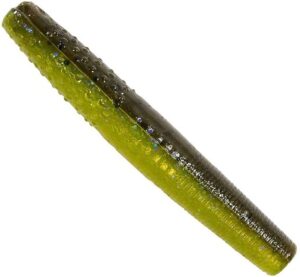 Fishing soft plastic via the Texas rig is staple for many bass anglers.
Fishing soft plastic via the Texas rig is staple for many bass anglers.
The Texas rig can be fished mind numbingly slow, or as fast as a bullet. Regardless of how you fish it you need a dependable reel to drop that bait in the perfect spot and be able to muscle that fish in after it’s hooked.
Fishing a Texas rigged bait has to be done using a baitcasting reel that has at least a gear ratio of least 6.5:1 or more.
The faster gear ratio is not needed to retrieve the bait quickly, but more to picking up slack line. If a fish bites your lure on very slack line you could miss the strike… then you’ll miss setting the hook.
What is the Best Fishing reel for Finesse fishing – drop shot, shaky head, Ned rig?
The great reel for finesse fishing needs to hands down be a spinning reel with a smooth drag.
Spinning reels allow you to cast an ultra-light lure extremely with ease.
We polled a bunch of professional anglers and asked what was the most important feature to a great spinning reel for finesse fishing. This is was their response…
94% said – the drag needs to super smooth. Reason: If you are hooked into a big bass while using 6-pound test line you’re going to need a smooth drag.
If the bass shakes it head and your reel cannot keep up with it, then could break itself off.
Some anglers will swear by buying a larger reel such as the 3000 or 4000 series reels in order to prevent line twists.
However the counter argument is the newer reels have fast retrieves, some as fast as 6.1:1 ratio that takes up nearly 36 inches of line with each turn of the handle.
We recommend a smaller reel in the 2500-3000 size series with a faster gear ratio. It will be lightweight and fast enough to pick up the slack line when a fish makes a break for deeper water
If you’re looking for a quality reel that you can rely on for years then look to getting a Daiwa Tatula LT Spinning Reel (TALT25000D-XH). Personally, I own several of these reels and I strongly recommend them. The drag is butter smooth and I rarely get any line twists.
Getting Started With Bass Fishing? Read These Articles First...
- How To Catch Bass – 57 Fool-Proof Methods To Start Bass Fishing [Made Easy!]
- 5 Best Bass Baits Every Angler Must Own (Are You Missing Out?)
- Best Bass Fishing Lures 2024: Comprehensive Buyers Guide
- Bass Fishing Rod Secrets: Helps You Chose The Right Type Of Rod Faster!
- 21 Tips To Choose The Best Bass Fishing Line
- WARNING: Don't Even Think About Trying To Buy Your Fishing Reel Until You Read This...
- Water Clarity Guide for Bass Fishing [Blueprint Revealed]
- Top Secret! Catch Bass From the Bank Every Time
- 25 Night Bass Fishing Tips and Tricks
More articles just for you...
Selecting Early Summer Bass Fishing Lures [Avoid 5 Common Mistakes]
A Complete Buyer’s Blueprint On The Best Early Summer Bass Lures On The Market Today! When it comes to bass fishing, choosing the right lure
Early Summer Bass Fishing [Avoid These 3 Sneaky Lies]
Learn these closely guarded secrets early summer bass fishing … and… dramatically boost your advantage over other anglers! Late spring to early summer bass fishing
Fear The Finesse? 7 Ned Rig Fishing Secrets Exposed!
Conquer the Fear of Finesse… and… Unlock the Potential Ned Rig Fishing – TODAY! Fellow Angler… Like most of you I’m pretty set in my
Fishing Spawning Bass [18+ Lures & Gear]
Get Ready For The Spawn Now When bed fishing, stealth is of the biggest essential tip. Instead of racing forward with a trolling motor, anglers
[2024 Editors Choice] Picking The Best Bass Fishing LINE For ANY Budget
What is the best bass fishing line? | What is a good fishing line for bass? The best type of bass fishing line is based
Drift Sock Basics – What It Is A Drift Sock & How To Use It [2024 Quick Start Guide]
What Does A Drift Sock Do? | Why Use A Drift Sock? photo cred: WLUK We’ve ALL been there… you work your butt off the
Accessories You’ll Need
Fishing Rod
 Rod –The popularity of fishing is growing and people are becoming much more conscious of different rods that can help them.
Rod –The popularity of fishing is growing and people are becoming much more conscious of different rods that can help them.
Fishermen want the best technique-specific rod for the money.
Luckily, the report I wrote provides you with detailed information in order for you to make buy the rod for the money, and more importantly which rods to avoid at all costs.
>> What Rods To Use For Bass Fishing? 10 Awesome General Purpose Rods Reviewed
Fishing Reel
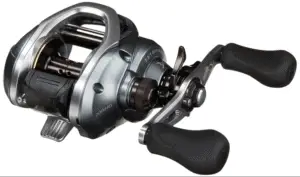
Reel – Having the correct reel to match with your rod is just as important. A good reel should be light and have a buttery smooth drag. There are several great reels on the market, but I recommend the a quality Shimano baitcasting reel. It’s a great reel packed with great features. So much so that it could easily be priced in the mid $200 range.
>>How To Choose A Great Bass Fishing Reel For The Money [and which to avoid at all costs]
Fishing Line
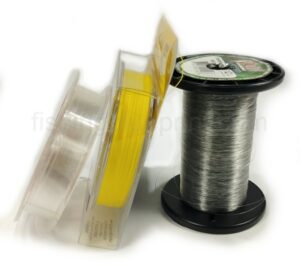
Fishing Line – Having a good line is just as important as having a good rod. I recommend fishing with a good fluorocarbon line. Furthermore, it’s super sensitive because it has little to no stretch, and underwater it’s invisible to the bass! If pride or money is on the line I would use Sunline Sniper FC.
>>21 Tips To Choose The Best Fishing Line
Fishing Lures & Baits

Fishing Lures – It’s pretty hard and darn near impossible trying to catch a fish without using some sort of lure or bait. More importantly these baits you should never forget at home or it could lead to a horrible day on the water
>>5 Bass Fishing Lures You Never Want to Leave At Home
Fish Finder
Finding lunker bass has never been easier when using a fish finding sonar unit. Packed with additional features to make your day on the water even easier. Maps that can plan your day or help you find your way back even in the darkest of nights. Bright bold numbers and letters to make reading the maps easy even in the brightest of days, and colors that pop and make it quick and easy to identify fish.
If you have a boat, kayak, canoe, or float tube, you need a fish finder.
Here’s our choice for the best fish finder between $299-$800:
Humminbird HELIX 7 CHIRP MEGA SI
It has all the features for any serious fisherman whether you’re an avid weekend warrior, or a tournament angler. This has all the bells and whistles you’re looking for.
>> Click HERE to Read The Reviews About Humminbird HELIX 7 CHIRP MEGA SI now
Here’s our choice for the best economic fish finder:
Garmin Stryker
While others look for bites, your fishfinder and GPS plotter help you reach your daily limit. You can mark preferred docks, ramps, and hotspots to easily return to them later and even share waypoints.
Click HERE to Read The Reviews About Garmin Stryker now!
Life Vest
According to Statista, “In the United States, 658 people died as a result of boating accidents and 2,641 people were injured in 2021.”
And it gets even worse… The National Safe Boating Council reported, “Where cause of death was known, 81% of fatal boating accident victims drowned.”
And if that’s not enough the incidence of deaths has climbed dramatically in recent years.
So if you’re on the water you NEED to wear your life vest. Protect you, your friends, and your families lives by wearing a life vest every time you’re on the water.
I recommend the ONYX PFD. It’s comfortable for all day use and there is lots of room for the air to move around so you won’t get sweaty.
>>Click HERE to read all the reviews actual customers!
Sunglasses
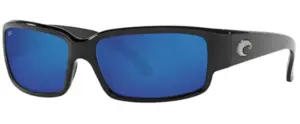 Sunglasses – Do you find yourself fishing in variable light and water conditions? Fishing in open water? Fishing in the bright hot sun? Then, only to leave the lake with eye strain and a splitting headache?
Sunglasses – Do you find yourself fishing in variable light and water conditions? Fishing in open water? Fishing in the bright hot sun? Then, only to leave the lake with eye strain and a splitting headache?
If so, I strongly recommend investing in a pair of Costa Sun Glasses. Thousands of anglers, charter guides, and tournament professionals put their trust into Costa, and so should you. Here’s why…
Costa’s co-injected bio-based nylon frame material is robust and durable, as well as extremely comfortable to wear for all-day use. TR-90 nylon is an excellent material for sports and performance frames since it is heat and cold-resistant.
Costa builds their glasses with class-leading technology. Their 580G glass lens sets them apart from the competition. These lenses are ideal for long days on the lake or sea since you won’t have to worry about scratches on the lens when you wipe the saltwater off. Needless to say they’re Costa’s most durable lenses.
Anyone who spends time outside, especially on the lake, needs polarized lenses. However, not all polarized sunglasses are the same. Costa is 99.9% polarized, giving it the most effective possible in blocking reflecting glare, and minimizing eye strain and headaches.
>>Click HERE to Read The Reviews On These Costa Sunglasses Right Now!
Drift Sock
Simply speaking, a drift sock (also known as a drift anchor) is like a parachute for the water. It gives you the ability to silently troll without spooking the fish!
Anyone who fishes out of a boat, canoe, kayak, stand up paddle board, or any other type of floating vessel should have a drift sock ready to use.
In addition to helping you catch more fish, recreational boaters also like to have 1-2 drift socks handy, just in case their motor goes out on them the drift sock will help slow their drift. This could be instrumental to allow rescuers to find that boat quickly and easily.
I strongly recommend the Drift Master Drift Sock by Mythik Outdoors.
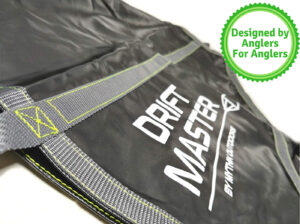 The construction is solid. Holding this in your hands gives you the peace of mind this feels durable and dependable.
The construction is solid. Holding this in your hands gives you the peace of mind this feels durable and dependable.
I love that it’s made from the gorilla-strong “RipStop” high density material, and I like that it’s even paired with the high-density nylon strapping.
It’s 30% stronger than other competitors who use a cheaper version of the RipStop material, so you never have to worry about his ripping.
Looking closely I can see they even triple stitched the high-tension points which is a good feature.
But best part… the Drift Master comes in a complete kit!
So get yours today and don’t leave yourself adrift.
The last thing to note is the Mythik Outdoors Drift Master drift sock kits sell out fast, so make sure you get yours before they’re gone!
>>Click HERE to Read The Reviews On This Drift Sock Today!
Landing Net
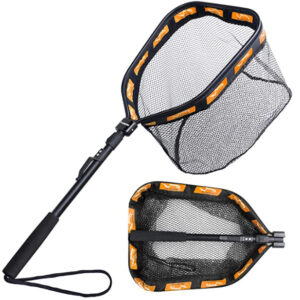 Landing Net – As you are reeling in that monster fish, you don’t want to injure yourself or knock the fish off the hook by trying to grab it.
Landing Net – As you are reeling in that monster fish, you don’t want to injure yourself or knock the fish off the hook by trying to grab it.
The PLUSINNO floating landing net is designed with foam padding on the hoop and provides buoyancy for fishermen. Now, If the net is dropped or blown overboard, the floating design makes it simple to retrieve – so you won’t have to be concerned about losing it! The rubberized net cannot be snagged. It keeps the fish safe for catch-and-release, and the non-absorbent covering avoids waterlogging and odor absorption in the net. It’s collapsing design allows for easy storage.
That’s why I recommend a dependable telescopic landing net.
>>Click HERE to Read The Reviews On This Floating Landing Net Today!
Fishing Weight Scale & Culler
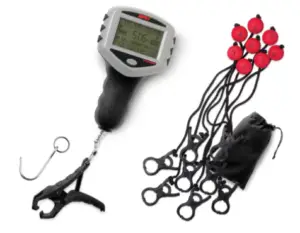 Fishing Weight Scale – Whether you’re going to keep your catch or just take a photo of it and brag to your friends it’s important to have an accurate scale. The Rapala Tournament Model Touch Screen Scale makes weighing and logging your catch easier and more convenient. The large digital scale has a lot of functions and is easy to use. simply keep track of your current catch and its place in your overall weight. To see the weight, just suspend the catch from the heavy-duty composite clamp or the accompanying stainless steel hook. Adding the important details to your catch couldn’t be easier – simply input your catch’s weight and tap on one of the eight storage places. The culling process makes it simple to identify fish that should be released for the greatest overall weight.
Fishing Weight Scale – Whether you’re going to keep your catch or just take a photo of it and brag to your friends it’s important to have an accurate scale. The Rapala Tournament Model Touch Screen Scale makes weighing and logging your catch easier and more convenient. The large digital scale has a lot of functions and is easy to use. simply keep track of your current catch and its place in your overall weight. To see the weight, just suspend the catch from the heavy-duty composite clamp or the accompanying stainless steel hook. Adding the important details to your catch couldn’t be easier – simply input your catch’s weight and tap on one of the eight storage places. The culling process makes it simple to identify fish that should be released for the greatest overall weight.
I recommend a Rapala Tournament Scale that has a large LED display like this one fishing scale here.
>>Click HERE to Read The Reviews on This Tournament-Grade Fishing Scale & Culling System now!
source [1]

